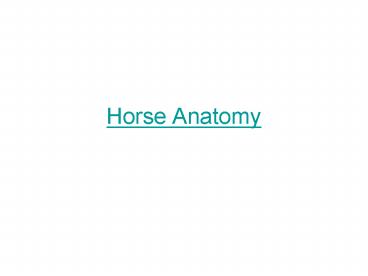Horse Anatomy - PowerPoint PPT Presentation
1 / 28
Title:
Horse Anatomy
Description:
Horse Anatomy Frog One of the most important, but often neglected structures of the horse s hoof. It should be wide and substantial and made up of thick, leathery ... – PowerPoint PPT presentation
Number of Views:176
Avg rating:3.0/5.0
Title: Horse Anatomy
1
Horse Anatomy
2
(No Transcript)
3
(No Transcript)
4
Frog
- One of the most important, but often neglected
structures of the horses hoof. It should be wide
and substantial and made up of thick, leathery
material. An unhealthy frog is vulnerable to
infection which, if left untreated, can lead to
significant loss of structure in the back of the
hoof causing severe lameness. - The frog works in concert with the coronary band,
the bars and the sole to provide resistance to
distortion of the hoof capsule during the stride.
- Pressure placed upon the frog directly influences
the health of the digital cushion above it. - The frog stay (triangular piece cut out of the
sole that the frog sits in) allows independent
movement at the heels as the horse lands on
uneven ground. The frog also plays a part in
protecting the sensitive structures beneath,
providing traction, assisting circulation and
absorbing shock.
5
Sole
- The sole is the area inside the white line, but
not including the bars and frog. Its primary
function is to protect the sensitive structures
beneath the sole. - However, the outer perimeter of sole also
provides support, sharing some of the weight of
the horse with the hoof wall.
6
White line
- The purpose of the Golden Line is to join the
sole to the inner wall of the hoof and to seal
off the border of the pedal bone to protect it
from bacterial infiltration. - It creates a shallow crease at the bottom of the
hoof which fills with dirt, aiding with traction. - Should not be penetrated by a nail during
shoeing.
7
Inner Wall
- The inner hoof wall is usually white (unlike the
outer wall, it does not contain pigment). It is
more pliable than the outer wall due to the
higher ratio of intertubular horn which bind the
tubules together.
8
Outer Wall
- The outer hoof wall is pigmented and contains a
higher ratio of tubules. These tube-like
structures grow down from the coronary band in a
spiral configuration. It has been suggested that
this makes them act like tiny springs, but this
cannot happen as there is no space between the
coils.
9
bone growth in the pastern or coffin joint
10
video
- http//video.google.com/videoplay?docid7742883613
355143098 - http//www.4act.com/training/play.aspx?cID143vID
1944
11
Digestive System
1. Mouth2. Pharynx3. Esophagus4. Diaphragm5.
Spleen6. Stomach7. Duodenum8. Liver, upper
extremity9. Large colon10. Coecum11. Small
intestine12. Floating colon13. Rectum14.
Anus15. Left kidney and its ureter16.
Bladder17. Urethra
12
(No Transcript)
13
Equine gastrointestinal anatomyGallbladder?
14
Fermentation occurs on the Cecum and colon.
15
Rectal Palpation
L side spleen, pelvic flexure, mesenteric root,
L kidney
R side Aorta, cecum
SI strangulation
Cecal tympany
Large colon impaction
16
Umbilicus, horse
17
(No Transcript)
18
(No Transcript)
19
(No Transcript)
20
(No Transcript)
21
- Thoracic limb
- support the weight of the front end of its body
while using a minimal amount of muscular activity - helps prevent fatigue of the limb muscles
- transfers weight from the thoracic limb muscles
to connective tissue structures that do not tire,
namely tendons, ligaments or bone - Pelvic Limb
- supports the weight of the caudal end of its body
allows the other pelvic limb to be placed in a
"resting" position tip toe - reduces the amount of energy (the amount of
muscular effort is not reduced) - Pelvic limb stifle locked, reciprocal mechanism
stifle and hock move in unison ligament/tendon
in distal limb
22
(No Transcript)
23
(No Transcript)
24
Lameness Exam - FL
25
Diagnostic Anesthesia
- ASEPSIS IS CRITICAL
- Scrub area with surgical scrub (chlorhexidine
gluconate or povidone iodine) for a full 5
minutes - Spray area with alcohol (do not allow alcohol to
drip from dirty to clean area) - Ensure adequate restraint (keep in mind that the
veterinarian is responsible for the safety of
everyone involved). Use of a twitch, lip chain or
nose chain is indicated. Chemical restraint may
be desirable when injecting into a joint to
ensure no movement of the horse - Use sterile gloves and an unopened bottle of
anesthetic agent - Determine landmarks for injection
- Insert need with quick, determined thrust
- Obtain joint fluid (if possible)
- Attach syringe and inject anesthetic agent -
fluid should inject freely, without resistance.
If resistance is met, it is advisable to
reposition needle, it is probably not intra-
articular. - Wait recommended amount of time and re evaluate
lameness
26
Palmar/Plantar Digital Nerve Block
- Structures Anesthetized
- Navicular bone
- Navicular bursa
- Distal sesamoidean ligaments
- Deep Digital Flexor tendon and sheath
- Digital cushion
- Corium of frog
- Palmar 1/3-2/3 of sole
- Palmar pastern and coffin joints
- Palmar distal phalanx / wings of coffin bone
- Palmar Skin
- Dx Navicular Syndrome, Heel Pain Syndrome, Wing
Fractures of P3, Subsolar abscess. /-Pedal
osteitis
27
Diagnostic Anesthesia
Fetlock
Pastern
Carpus
28
References
- http//cal.vet.upenn.edu/projects/grossanat/index.
htm - http//www.vet.cornell.edu/oed/horsedissection/Sea
rch.asp?FunSBM































